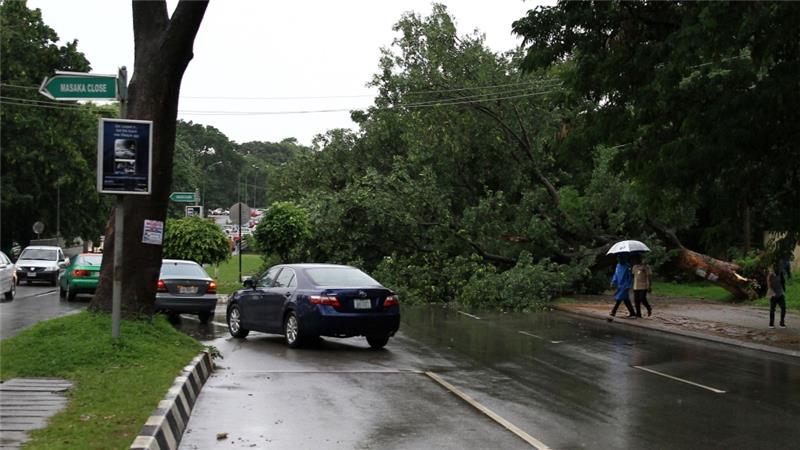
Coping with the rage of nature can be quite challenging, especially for a nation that is ill-equipped to manage disasters. That is why this year’s Annual Flood Outlook presented by the Nigeria Hydrological Services Agency should be of interest to the Nigerian authorities ahead of what could be another trying period for the country.
In what could be a repeat of the 2012 experience, where many states were submerged by floodwater for weeks, the agency warned of the imminence of flooding in 35 out of the 36 states in the country and the Federal Capital Territory. It means that the entire country practically faces the threat of going under water, which comes with serious humanitarian challenges, such as providing a roof over displaced people’s heads, feeding them, clothing them and providing them with medical care, among other things.
Early signs of what lies ahead were evident in the collapse on June 16 of two important bridges linking the northern parts of the country to the southern parts. The Tatabu Bridge and Bokani Bridge in Niger State were washed away after a torrential rainfall, ensuring that vehicular traffic from that part of the country was prevented from accessing the southern part, and vice versa. This has resulted in a two-week suspension of the Kano-Lagos train operations, during which time the failed portions are expected to be repaired. Heavy flooding has also been reported in Bayelsa, Imo and Oyo states.
During a similar incident in 2012, 431 people were reported dead across the country, with about 1.3 million others displaced and hundreds of acres of farmland submerged, as rivers burst their banks due to massive flooding occasioned by heavy rainfall. Farmers lost their entire season’s crops while many houses and roads were destroyed in what was reportedly the worst flood incident in the country in 40 years. Then, 30 states were affected, forcing the then President, Goodluck Jonathan, to set up the Committee on Flood Relief and Rehabilitation, co-led by businessman, Aliko Dangote, and Lawyer, Olisa Agbakoba, to raise funds to provide relief materials for those that were affected.
This year’s forecast is even more alarming, to say the least; but flooding is fast becoming the trend the world over. In Sri Lanka, on May 26, CNN, quoting the country’s Disaster Management Centre, reported the death of no fewer than 91 people, with 100 others missing, following heavy flooding and landslide as a result of monsoon rains. Thailand had experienced the same fate in January, when heavy flooding claimed 12 lives, with many villages submerged.
In an earlier incident in 2015, a Mail Online report said that no fewer than 82 lives were lost in the worst flooding in Europe in decades. About 58 of the dead were reported in the Black Sea area where many Russian tourists had their cars and tents swept into the sea by floodwater. In Prague, the capital of Czech Republic, over 50 people, including visitors, were evacuated in the worst flooding incident in more than a century. Many other cities in Austria, Germany and Croatia were also affected, with buildings either partially or totally submerged.
The phenomenon of flooding has been strongly linked to global warming and the melting glacier of the Polar Regions, which have led to a substantial rise in seawater levels. Experts say that the rising global temperature was consistent with heavy rainfall experienced across the world, since “warmer air holds more moisture.” The Union of Concerned Scientists, an organisation concerned about a healthy planet and safer world, says, “When warm air holding moisture meets cooler air, the moisture condenses into tiny droplets that float in the air. If the drops get bigger and become heavy enough, they fall as precipitation (rain).”
Warnings such as the one from NIHSA are not meant to stop the forces of nature from having their way, but to help humans to plan in many ways. For example, the Nigerian Meteorological Agency issued sufficient warning in 2012 about the impending floods, but it was not heeded. This was probably why the impact was so devastating. The current warning is, therefore, meant to guide farmers, for instance, on when to plant so that their crops would not be washed away. It is also a reminder on the need to keep water channels free so that when it rains the water will quickly find its way into the sea, rivers and streams, instead of collecting as a result of blocked channels.
Apart from clearing drainage channels to allow for the free passage of water, this is the time for city planners to remove obstructions on water paths, including buildings illegally constructed on such places. Coastal cities like Lagos, Calabar and Port Harcourt are more likely to be affected by flash flood, but if the drainage system is not blocked, the water would quickly disappear when the rain stops. It will help to mitigate the impact.
Managers of the various dams across the country should also be careful when releasing excess water from their dams. Indiscriminate release of water from the dams has been one of the reasons for flooding in the country. When there is the need to release water, it should be done in a controlled manner.
The National Emergency Management Agency and other emergency response organisations should also be well equipped to be able to respond when the need arises. In Nigeria, the response has always been poor, riddled with stories of diversion of materials for private use and people turning up at disaster areas without the knowledge of what steps to take. There may also be the need for evacuation. This is the time to prepare adequately, so that, once again, the country would not be taken by surprise.
END

Be the first to comment